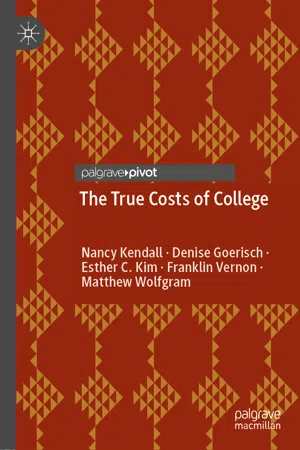Equity and Higher Education
A college degree has never been more necessary for achieving economic security and improved quality of life in the United States (Baum, Ma, & Payea, 2010; Bloom, Hartley, & Rosovsky, 2006; Carnevale, Rose & Cheah, 2011; Hout, 2012). At the same time, class inequalities (which in the United States are deeply intertwined with racial, ethnic, geographical, gender, sexual identity, disability, and other inequalities)1 in college access, achievement, and completion have never been greater. In 2012, only 14% of students from the lowest income quartile had earned a bachelor’s degree; in contrast, 29% from the middle two quartiles, and 60% of students from the wealthiest income quartile, achieved that milestone (Bowen & McPherson, 2016). As Rauscher and Elliott III (2014) succinctly state: “In order for education to be an arbiter of intergenerational mobility,... United States policy must address the wide gap in educational attainment among different economic classes” (p. 283).
While the effects of higher education on individual mobility and well-being have never been greater, a growing body of research indicates that it is becoming harder and harder for lower- and middle-class families to access college opportunities and degrees. The relative gap between low-income and high-income college students’ enrollment has never been larger (Scott-Clayton, 2015), and greater numbers of academically qualified, low-income students are foregoing college or stopping out (Bowen & McPherson, 2016; Long & Riley, 2007). This gap has increased as low-income families’ costs have increased: families in the bottom 25% of the income distribution now have to pay on average almost 60% of their annual income to send one child to a four-year public university (Radwin, Wine, Siegel, & Bryan, 2013).2
The rising costs of college for families (and particularly low-income families) has been fueled by a number of factors, including rapid declines in public funding for public higher education. Facing radical budget cuts, universities often shifted costs onto individual students and families by raising tuition and other costs of attendance (Mettler, 2014). Federal and state financial aid have generally not kept up with increased costs of attendance and the larger number of students who hope to pursue a college degree. As a result, by 2015/2016, the average unmet need for full-time students at a four-year public college was $14,400, but low-income students had the largest amount of unmet financial need (Baum, Ma, Pender & Libasi, 2019). Grant (as opposed to aid) money has been particularly hard-hit: in the 1970s, federal Pell grants covered about 75% of official costs at public, four-year colleges and universities; by 2014, they covered only about 30% of official costs (Goldrick-Rab & Kendall, 2014). State, institutional, and private need-based funding also declined, while merit-based aid—which generally compounds existing social inequities—increased (Doyle, 2010).
While costs for higher education shifted from the public onto individual families and students, constant-dollar wages for “private, middle-class wage-earners” in the United States on average declined over the last 45 years by over 11% (Mislinski, 2020). This decline was not equally distributed; like increasing gaps in wealth and homeownership, it was particularly steep for Black workers, and particularly Black women (Wilson & Rodgers III, 2016). Not surprisingly, then, student loan debt for UW System Bachelor’s degree-holders increased rapidly, more than doubling in constant dollars since 1992 to over $30,000 (Kyle & Shastri, 2018), as students increasingly have to reach beyond the resources available to them and their families to finance their college education.
The consequences of increased reliance on student debt to fuel college-going are again unequal, reflecting racialized and geographical inequities in public subsidies for homeownership, transportation, businesses, and other forms of wealth-creation that have left Black, Indigenous, and Hmong families in Wisconsin facing hurdles in wealth creation that White families on average have not faced.3 In 2016, for example, the poverty rate for Black families in Wisconsin was three to four times higher than for White families, and Latinx and Hmong family poverty rates were more than double the rate for White families (Smeeding & Thornton, 2018). As a result of these historic and continuing systemic inequities, the students in our studies who identified as Black, Indigenous, or People of Color on average had many fewer familial resources to draw on to support their college-going, which in turn meant that the unexpectedly high true costs of college had a particularly negative impact on their experiences and well-being.
This book examines the true costs of attending a public, four-year college, and the impact of these costs on low- and moderate-income4 students’ college experiences, academic pathways, and outcomes. The book aims to shift the way we think about college costs and their relationships to students’ college experiences, thereby deepening our understanding of what drives the class gap in college attainment and outcomes and allowing us to propose better policy responses. More specifically, drawing on research conducted from 2014–2016 with first- and second-year, low-and moderate-income students at four public, four-year colleges in Wisconsin, the book aims to provid...
